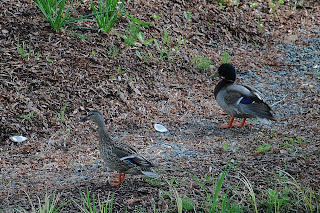Dressed as they were in their brilliant mating plumage, the males stood out with glossy green heads and upper necks. These were separated from their light grey breasts and rusty colored backs by white rings resembling collars. The bottom edge of each of their wings held a bright blue rectangle and a white bar at the point where they met the body; each had the yellowish green bill and two distinct black feathers that curve back, giving them their characteristic curly tails.
As I peered out from the window above, I could hear the frantic splashing - their interaction was intense, but short-lived.
During the fray the female, much less colorful and smaller than the drakes, was nonchalant, casually swimming about out of their way and grooming herself... such a lady. The hen’s back and breast is a darker brown than the drake’s, and she does not have the same distinct curly tail. She has an orange bill, occasionally marked with black spots, orange legs and feet, and the same distinguishing blue rectangle and white bar on each wing.
The female probably has searched for, and staked out, a territory for her nest; the drake just followed along, as any good spouse might when it comes to housekeeping. Females typically try to locate a territory close to where they themselves were hatched, often returning to the same site year after year. Since we've seen at least one pair each year visit our small pond, their presence does not surprise me. The nesting site is sometimes close to a source of water but more often a small distance away in an area lined with bits of rushes, grass, weeds, and other organic material. The nest, built solely by the female, is usually somewhere with good cover such as thick grass or shrubs or in the hollow of a tree up to 12.2 m (40 ft.) off the ground. That would certainly explain the One Giant Leap we witnessed near the Yakima River some years back. These do not seem to nest near our pond, as we keep the area around it fairly cleared. With a multitude of ponds, drainage ditches, and thick brush in our neighborhood, they have a choice of good nesting spots. Perhaps in future years, when the plantings around our newly renovated pond mature, they'll nest closer by.
Ducks drop by here simply to dabble about for worms, tadpoles, small frogs, insects, and freshwater snails found in muddy areas along the edge. They scrounge in deeper water to feed from the mud below, using their bill as a very efficient filtration system similar to that of the baleen whale. In other areas they may find small fish, mollusks and fish eggs. Primarily vegetarians, Mallards feed day and night on leaves, seeds, berries, corn, bulrushes, wild rice, wheat, primrose, willows, and seeds of water elm, oak, hackberry. The battle over, the female, still unruffled by the whole affair (or, not-to-be affair?) came out of the pond and waddled up the small hill to preen and rest, her loyal drake following docilely behind.
Perhaps in the depths of his little duck brain he knows that in the next month he will begin to lose his colorful feathers and be unable to fly until his new feathers have grown in. Until breeding season returns in August, he will be a drab brown and more closely resemble her. He will likely remain in their nesting territory for the first ten days or so that she incubates the eggs, and then abandon her.
Most Mallard (Anas platyrhynchos) drakes are a fickle sort - best they strut their vanity while they can.




















































